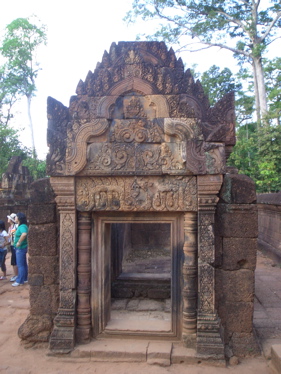
Siem Reap Town - the gateway to the Angkor Archaeological Park
This town has colonial and Chinese-style architecture in the Old French Quarter, and around the Old Market. In town, there are Apsara dances, craft shops, silk farms, rice-paddy countryside, fishing villages and a bird sanctuary near the Tonle Sap Lake. Almost all hotels are located in or near Siem Reap Town. The entrance to the park lies about 3km north of the town center. Siem Reap today, being a popular tourist destination, has a large number of hotels and restaurants. It is also well-known as a small charming gateway town to the world famous heritage the Angkor temples.
Angkor Wat Over a period of 300 years, between 900 and 1200 AD, the Khmer Kingdom of Angkor produced some of the world's most magnificent architectural masterpieces on the northern shore of the Tonle Sap, near the present town of Siem Reap. The Angkor area stretches 15 miles east to west and 5 miles north to south. Some 72 major temples or other buildings dot the area. Suryavarman II built the principal temple, Angkor Wat, between 1112 and 1150. With walls nearly one-half mile on each side, Angkor Wat portrays the Hindu cosmology with the central towers representing Mount Meru, home of the gods; the outer walls, the mountains enclosing the world; and the moat, the oceans beyond. Angkor Thom, the capital city built after the Cham sack of 1177, is surrounded by a 300-foot wide moat. Construction of Angkor Thom coincided with a change from Hinduism to Buddhism. Temples were altered to display images of the Buddha, and Angkor Wat became a major Buddhist shrine.
During the 15th century, nearly all of Angkor was abandoned after Siamese attacks. The exception was Angkor Wat, which remained a shrine for Buddhist pilgrims. The great city and temples remained largely cloaked by the forest until the late 19th century when French archaeologists began a long restoration process. France established the Angkor Conservancy in 1908 to direct restoration of the Angkor complex. For the next 64 years, the conservancy worked to clear away the forest, repair foundations, and install drains to protect the buildings from their most insidious enemy: water. After 1953, the conservancy became a joint project of the French and Cambodian Governments. Some temples were carefully taken apart stone by stone and reassembled on concrete foundations. Tourism is now the second-largest foreign currency earner in Cambodia's economy, and Angkor Wat has helped attract international tourism to the country.
|
|
|







